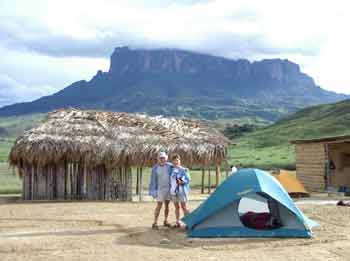From The California Native Newsletter:
Journey to the Lost World
 By
Ellen Klein By
Ellen Klein
“From the side of the plateau on
which we were, slopes of woodland, with occasional glades, stretched down
for 5 or 6 miles to the central lake. I could see at my very feet the glade
of the iguanodons, and farther off was...the swamp of the pterodactyls...I
could see a number of dark holes...which I conjectured to be the mouths
of the caves.”
The Lost World, Sir Arthur Conan Doyle
Roraima Tepuy strikes a mystical silhouette against
the cloudy southeastern Venezuelan sky and after three days of hiking
and climbing, we reached its top. I looked expectantly for dinosaurs
and cavemen, but saw only spectacular rock formations, exotic foliage
and pools of water. Some of the rocks did resemble dinosaurs, however,
and I knew we had arrived at the “lost world” made famous
in Sir Arthur Conan Doyle’s 1912 novel.
Tepuy is the Pemon Indian word for “tabletop mountain.” These
ancient volcanic mesas dot the landscape of Venezuela’s Gran Sabana.
Each tepuy has its own unique ecological system where plants and animals,
at one time thought to be extinct, still exist. Much of this area is
encompassed by Canaima National Park, covering 11,600 square miles of
grassy plains, tropical rainforests and rivers. Its unique flora includes
endemic insectivorous plants, colossal bromeliads and fabulous orchids.
The area is famous for the beauty of its waterfalls which cascade down
from the Tepuys, including Angel Falls, the world’s highest.
Roraima Tepuy is situated in the three-country-triangle formed by Venezuela,
Guayana and Brazil. The highest of the Tepuys, at over 9700 feet, its
surface measures 12 square miles. Roraima, meaning “mother of all
waters” in the Pemon Indian language, was first reported by Sir
Walter Raleigh when he explored the area in his search for El Dorado,
the fabled land of gold. In 1884 two English explorers were the first
to climb to the top of the tepuy.
Climbing Roraima was truly an adventure. We spent our first two days
crossing the Gran Sabana, enjoying its landscape, and wading across the
Tek and Kukenan Rivers. On the third day we left the base camp and headed
up the massive walls on a rocky trail, climbing through tropical rain
forests and sheer cliffs affording spectacular views. At one point we
were soaked as the trail led us through a waterfall. When we reached
the top, it was almost like walking on the moon—like nothing I
had ever experienced before in my life. Strange formations of black igneous
rock, believed to be over 1.8 million years old and eroded into all manner
of strange shapes, dotted the landscape. Growing amidst the rocks were
strange carnivorous plants. Cascades of water formed pools which sparkled
in the bazaar landscape. Shallow caves along ledges in the eroding rock
made a perfect “hotel” for pitching our tent.
Atop the tepuy the weather changes constantly, as clouds rolling over
cause one minute to be grey and dark, and the next bright and sunny,
then the scenery fades behind a curtain of light rain. We spent two nights
in this lost world, exploring the flora and fauna, and the crystal valleys
where thousands of quartz crystals cover the ground. At night the skies
were spectacular.
We bathed in the “jacuzzis,” small deep pools among the rocks.
Others did a more strenuous hike to “three points,” a stone
that marks the point where the three national borders meet. We also climbed
the “car,” a rock formation that looks very much like a Ford
Fairlane, and happens to be the highest point on the tepuy, offering
a spectacular view of the Gran Sabana below.
It took us two days to hike back to the trailhead in the Indian town
of Paraytepui, where Pemon Indians who work for the park carefully check
every bag to make sure no crystals have been taken, and that everything,
including all trash, that went up the mountain came back down.
No dinosaurs at the top of Roraima but an unforgettable adventure in
a lost world!
|


 By
Ellen Klein
By
Ellen Klein 